On the Potential of Sentinel-1 for High Resolution Monitoring of Water Table Dynamics in Grasslands on Organic Soils
Abstract
1. Introduction
- the correlation of WTD and σ0 at several study sites
- the effects of vegetation, soil properties, and the overall site wetness (characterized by mean WTD) on correlation coefficients
- the influence of grassland management practices at two exemplary study sites.
2. Materials and Methods
2.1. Study Area
2.2. In Situ Data: Water Table, Soil and Vegetation
2.3. Sentinel-1 Data
2.3.1. Data Availability and Scene Filtering
2.3.2. Data Processing
2.3.3. Derivation of Slopes of σ0 Incidence Angle Dependency
2.3.4. Correlation Analysis
3. Results
3.1. Influence of Polarization, Incidence Angle Normalization and Orbit on the Correlation of WTD and Backscatter
3.2. Influence of Mean WTD, Vegetation and Soil on the Correlation between WTD and Backscatter
3.3. Exemplary Time Series: Influence of Grassland Management Activities
4. Discussion
4.1. General Dependency of Backscatter on WTD
4.2. Influence of Mean WTD and Soil Properties on Correlation
4.3. Influence of Vegetation on Correlations and Backscatter Time Series
5. Conclusions
Supplementary Materials
Author Contributions
Funding
Acknowledgments
Conflicts of Interest
Appendix A
| Vegetation Class | Description | Name of Subclass | Habitat Types Code | Biotope Types Code |
|---|---|---|---|---|
| Mesophile grassland | Moderately dry to moderately wet nutrient-rich sites | Mesophile grassland | GMA | GM |
| Other mesophile grassland | GMX | |||
| Lowland hay meadow | Extensively managed, species-rich hay meadows rich in flowers | Lowland hay meadow | 6510 | 6510 |
| Wet grassland | Moderately wet to wet grassland, extensively used or fallow | Wet grassland | GF | |
| Fallow of wet grassland | GFX | |||
| Periodically flooded grassland | GFE | |||
| Other wet grassland | GFY | GF | ||
| Sedges | Mainly sedges at wet sites | Sedges | NSD |
References
- Yu, Z.; Loisel, J.; Brosseau, D.P.; Beilman, D.W.; Hunt, S.J. Global peatland dynamics since the Last Glacial Maximum. Geophys. Res. Lett. 2010, 37, L13402. [Google Scholar] [CrossRef]
- Boden, A.G. Ad-hoc-AG Boden Bodenkundliche Kartieranleitung KA5, 5th ed.; Schweizerbart: Hannover, Germany, 2005; pp. 257–263. [Google Scholar]
- Dettmann, U.; Bechtold, M.; Viohl, T.; Piayda, A.; Sokolowsky, L.; Tiemeyer, B. Evaporation experiments for the determination of hydraulic properties of peat and other organic soils: An evaluation of methods based on a large dataset. J. Hydrol. 2019, 575, 933–944. [Google Scholar] [CrossRef]
- Paavilainen, E.; Päivänen, J. Peatland Forestry: Ecology and Principles; Ecol. Stud. 111.; Springer: Berlin/Heidelberg, Germany, 1995. [Google Scholar]
- Tiemeyer, B.; Albiac Borraz, E.; Augustin, J.; Bechtold, M.; Beetz, S.; Beyer, C.; Drösler, M.; Ebli, M.; Eickenscheidt, T.; Fiedler, S.; et al. High emissions of greenhouse gases from grasslands on peat and other organic soils. Glob. Chang. Biol. 2016, 22, 4134–4149. [Google Scholar] [CrossRef] [PubMed]
- Wilson, D.; Blain, D.; Couwenberg, J.; Evans, C.D.; Murdiyarso, D.; Page, S.E.; Renou-Wilson, F.; Rieley, J.O.; Sirin, A.; Strack, M.; et al. Greenhouse gas emission factors associated with rewetting of organic soils. Mires Peat 2016, 17, 4. [Google Scholar] [CrossRef]
- Umweltbundesamt. Submission under the United Nations Framework Convention on Climate Change and the Kyoto Protocol 2018 National Inventory Report for the German Greenhouse Gas Inventory 1990–2016; Umweltbundesamt: Dessau-Roßlau, Germany, 2018. [Google Scholar]
- Arets, E.J.M.M.; Van Der Kolk, J.W.H.; Hengeveld, G.M.; Lesschen, J.P.; Kramer, H.; Kuikman, P.J.; Schelhaas, M.J. Greenhouse Gas Reporting for the LULUCF Sector in the Netherlands Methodological Background, Update 2018; Wageningen University and Research: Wageningen, The Netherlands, 2018. [Google Scholar]
- Dettmann, U.; Bechtold, M. Deriving Effective Soil Water Retention Characteristicsfrom Shallow Water Table Fluctuations in Peatlands. Vadose Zone J. 2016, 15, 1–13. [Google Scholar] [CrossRef]
- Dettmann, U.; Bechtold, M.; Frahm, E.; Tiemeyer, B. On the applicability of unimodal and bimodal van Genuchten-Mualem based models to peat and other organic soils under evaporation conditions. J. Hydrol. 2014, 515, 103–115. [Google Scholar] [CrossRef]
- Kerr, Y.H.; Waldteufel, P.; Richaume, P.; Wigneron, J.P.; Ferrazzoli, P.; Mahmoodi, A.; Al Bitar, A.; Cabot, F.; Gruhier, C.; Juglea, S.E.; et al. The SMOS soil moisture retrieval algorithm. IEEE Trans. Geosci. Remote Sens. 2012, 50, 1384–1403. [Google Scholar] [CrossRef]
- Entekhabi, D.; Njoku, E.G.; O’Neill, P.E.; Kellogg, K.H.; Crow, W.T.; Edelstein, W.N.; Entin, J.K.; Goodman, S.D.; Jackson, T.J.; Johnson, J.; et al. The soil moisture active passive (SMAP) mission. Proc. IEEE 2010, 98, 704–716. [Google Scholar] [CrossRef]
- Gruber, A.; Scanlon, T.; van der Schalie, R.; Wagner, W.; Dorigo, W. Evolution of the ESA CCI Soil Moisture Climate Data Records and their underlying merging methodology. Earth Syst. Sci. Data 2019, 11, 717–739. [Google Scholar] [CrossRef]
- Tsyganskaya, V.; Martinis, S.; Marzahn, P.; Ludwig, R. Detection of temporary flooded vegetation using Sentinel-1 time series data. Remote Sens. 2018, 10, 1286. [Google Scholar] [CrossRef]
- Kasischke, E.S.; Smith, K.B.; Bourgeau-Chavez, L.L.; Romanowicz, E.A.; Brunzell, S.; Richardson, C.J. Effects of seasonal hydrologic patterns in south Florida wetlands on radar backscatter measured from ERS-2 SAR imagery. Remote Sens. Environ. 2003, 88, 423–441. [Google Scholar] [CrossRef]
- Wagner, W.; Lemoine, G.; Rott, H. A method for estimating soil moisture from ERS Scatterometer and soil data. Remote Sens. Environ. 1999, 70, 191–207. [Google Scholar] [CrossRef]
- Kasischke, E.S.; Bourgeau-Chavez, L.L.; Rober, A.R.; Wyatt, K.H.; Waddington, J.M.; Turetsky, M.R. Effects of soil moisture and water depth on ERS SAR backscatter measurements from an Alaskan wetland complex. Remote Sens. Environ. 2009, 113, 1868–1873. [Google Scholar] [CrossRef]
- Gao, Q.; Zribi, M.; Escorihuela, M.J.; Baghdadi, N. Synergetic use of Sentinel-1 and Sentinel-2 data for soil moisture mapping at 100 m resolution. Sensors 2017, 17, 1966. [Google Scholar] [CrossRef] [PubMed]
- Wagner, W.; Lemoine, G.; Borgeaud, M.; Rott, H. A study of vegetation cover effects on ERS scatterometer data. IEEE Trans. Geosci. Remote Sens. 1999, 37, 938–948. [Google Scholar] [CrossRef]
- Dettmann, U.; Bechtold, M. Evaluating Commercial Moisture Probes in Reference Solutions Covering Mineral to Peat Soil Conditions. Vadose Zone J. 2018, 17, 1–6. [Google Scholar] [CrossRef]
- Dorigo, W.A.; Wagner, W.; Hohensinn, R.; Hahn, S.; Paulik, C.; Xaver, A.; Gruber, A.; Drusch, M.; Mecklenburg, S.; Van Oevelen, P.; et al. The international soil moisture network: A data hosting facility for global in situ soil moisture measurements. Hydrol. Earth Syst. Sci. 2011, 15, 1675–1698. [Google Scholar] [CrossRef]
- Harris, A.; Bryant, R.G. A multi-scale remote sensing approach for monitoring northern peatland hydrology: Present possibilities and future challenges. J. Environ. Manag. 2009, 90, 2178–2188. [Google Scholar] [CrossRef]
- Meingast, K.M.; Falkowski, M.J.; Kane, E.S.; Potvin, L.R.; Benscoter, B.W.; Smith, A.M.S.; Bourgeau-Chavez, L.L.; Miller, M.E. Spectral detection of near-surface moisture content and water-table position in northern peatland ecosystems. Remote Sens. Environ. 2014, 152, 536–546. [Google Scholar] [CrossRef]
- Kalacska, M.; Arroyo-Mora, J.P.; Soffer, R.J.; Roulet, N.T.; Moore, T.R.; Humphreys, E.; Leblanc, G.; Lucanus, O.; Inamdar, D. Estimating Peatland water table depth and net ecosystem exchange: A comparison between satellite and airborne imagery. Remote Sens. 2018, 10, 687. [Google Scholar] [CrossRef]
- Dabrowska-Zielinska, K.; Musial, J.; Malinska, A.; Budzynska, M.; Gurdak, R.; Kiryla, W.; Bartold, M.; Grzybowski, P. Soil moisture in the Biebrza Wetlands retrieved from Sentinel-1 imagery. Remote Sens. 2018, 10, 1979. [Google Scholar] [CrossRef]
- Lievens, H.; Verhoest, N.E.C. Spatial and temporal soil moisture estimation from RADARSAT-2 imagery over Flevoland, The Netherlands. J. Hydrol. 2012, 456–457, 44–56. [Google Scholar] [CrossRef]
- Torbick, N.; Persson, A.; Olefeldt, D.; Frolking, S.; Salas, W.; Hagen, S.; Crill, P.; Li, C. High Resolution Mapping of Peatland Hydroperiod at a High-Latitude Swedish Mire. Remote Sens. 2012, 4, 1974–1994. [Google Scholar] [CrossRef]
- Kim, J.-W.; Lu, Z.; Gutenberg, L.; Zhu, Z. Characterizing hydrologic changes of the Great Dismal Swamp using SAR/InSAR. Remote Sens. Environ. 2017, 198, 187–202. [Google Scholar] [CrossRef]
- Bechtold, M.; Schlaffer, S.; Tiemeyer, B.; De Lannoy, G. Inferring water table depth dynamics from ENVISAT-ASAR C-band backscatter over a range of peatlands from deeply-drained to natural conditions. Remote Sens. 2018, 10, 536. [Google Scholar] [CrossRef]
- Torres, R.; Snoeij, P.; Geudtner, D.; Bibby, D.; Davidson, M.; Attema, E.; Potin, P.; Rommen, B.Ö.; Floury, N.; Brown, M.; et al. GMES Sentinel-1 mission. Remote Sens. Environ. 2012, 120, 9–24. [Google Scholar] [CrossRef]
- Untenecker, J.; Tiemeyer, B.; Freibauer, A.; Laggner, A.; Braumann, F.; Luterbacher, J. Fine-grained detection of land use and water table changes on organic soils over the period 1992–2012 using multiple data sources in the Drömling nature park, Germany. Land Use Policy 2016, 57, 164–178. [Google Scholar] [CrossRef]
- Langheinrich, U.; Braumann, F.; Lüderitz, V. Niedermoor- und Gewässerrenaturierung im Naturpark Drömling (Sachsen-Anhalt). Waldokologie Online 2010, 10, 23–29. [Google Scholar]
- DWD Climate Data Center. Available online: Ftp://ftp-cdc.dwd.de/pub/CDC/observations_germany/ climate/ (accessed on 20 January 2017).
- Landesamt für Landesvermessung und Datenverarbeitung. Projektbericht Drömling, (Internal Report); Landesamt für Landesvermessung und Datenverarbeitung: Halle, Germany, 1999. [Google Scholar]
- IUSS Working Group WRB. World Reference Base for Soil Resources 2014, Updated 2015 International Soil Classification System for Naming Soils and Creating Legends for Soil Maps; FAO: Rome, Italy, 2015. [Google Scholar]
- LAU (Landesamt für Umweltschutz Sachsen-Anhalt). Kartieranleitung Lebensraumtypen Sachsen-Anhalt Teil Offenland; LAU: Halle/Saale, Germany, 2010. [Google Scholar]
- Von Drachenfels, O. Kartierschlüssel für Biotoptypen in Niedersachsen: Unter Besonderer Berücksichtigung der Gesetzlich Geschützten Biotope Sowie der Lebensraumtypen von Anhang I der FFH-Richtlinie; 8. Auflage.; Naturschutz Landschaftspfl. Niedersachs. Heft A/4: Hannover, Germany, 2011. [Google Scholar]
- LAU (Landesamt für Umweltschutz Sachsen-Anhalt). Erläuterungen zur Qualität und Anwendung der Ergebnisse der CIR-Luftbild-Gestützten Biotoptypen- und Nutzungstypenkartierung im Land Sachsen-Anhalt; LAU: Hualpén, Chile, 1999. [Google Scholar]
- ESA Copernicus Open Access Hub. Available online: https://scihub.copernicus.eu/ (accessed on 1 August 2018).
- ESA (European Space Agency). SNAP—ESA Sentinel Application Platform. Available online: https://step.esa.int/main/ download/snap-download/ (accessed on 10 April 2018).
- R-Development Core Team R: A Language and Environment for Statistical Computing. Available online: https://www.r-project.org/ (accessed on 12 February 2018).
- Steele-Dunne, S.C.; Hahn, S.; Wagner, W.; Vreugdenhil, M. Investigating vegetation water dynamics and drought using Metop ASCAT over the North American Grasslands. Remote Sens. Environ. 2019, 24, 219–235. [Google Scholar] [CrossRef]
- Dorigo, W.A.; Gruber, A.; De Jeu, R.A.M.; Wagner, W.; Stacke, T.; Loew, A.; Albergel, C.; Brocca, L.; Chung, D.; Parinussa, R.M.; et al. Evaluation of the ESA CCI soil moisture product using ground-based observations. Remote Sens. Environ. 2015, 162, 380–395. [Google Scholar] [CrossRef]
- Pfeil, I.; Vreugdenhil, M.; Hahn, S.; Wagner, W.; Strauss, P.; Blöschl, G. Improving the seasonal representation of ASCAT soil moisture and vegetation dynamics in a temperate climate. Remote Sens. 2018, 10, 1788. [Google Scholar] [CrossRef]
- Kim, S. PPCOR: An R package for a fast calculation to semi-partial correlation coefficients. Commun. Stat. Appl. Methods 2015, 22, 665–674. [Google Scholar] [CrossRef] [PubMed]
- Bourgeau-Chavez, L.L.; Kasischke, E.S.; Riordan, K.; Brunzell, S.; Nolan, M.; Hyer, E.; Slawski, J.; Medvecz, M.; Walters, T.; Ames, S. Remote monitoring of spatial and temporal surface soil moisture in fire disturbed boreal forest ecosystems with ERS SAR imagery. Int. J. Remote Sens. 2007, 28, 2133–2162. [Google Scholar] [CrossRef]
- Zwieback, S.; Berg, A.A. Fine-scale SAR soil moisture estimation in the subarctic tundra. IEEE Trans. Geosci. Remote Sens. 2019, 57, 4898–4912. [Google Scholar] [CrossRef]
- Naeimi, V.; Scipal, K.; Bartalis, Z.; Hasenauer, S.; Wagner, W. An improved soil moisture retrieval algorithm for ERS and METOP scatterometer observations. IEEE Trans. Geosci. Remote Sens. 2009, 47, 1999–2013. [Google Scholar] [CrossRef]
- Greifeneder, F.; Notarnicola, C.; Hahn, S.; Vreugdenhil, M.; Reimer, C.; Santi, E.; Paloscia, S.; Wagner, W. The added value of the VH/VV polarization-ratio for global soil moisture estimations from scatterometer data. IEEE J. Sel. Top. Appl. Earth Obs. Remote Sens. 2018, 11, 3668–3679. [Google Scholar] [CrossRef]
- Akbar, R.; Gianotti, D.S.; McColl, K.A.; Haghighi, E.; Salvucci, G.D.; Entekhabi, D. Hydrological storage length scales represented by remote sensing estimates of soil moisture and precipitation. Water Resour. Res. 2018, 54, 1476–1492. [Google Scholar] [CrossRef]
- Bechtold, M.; Dettmann, U.; Wöhl, L.; Durner, W.; Piayda, A.; Tiemeyer, B. Comparing methods for measuring water retention of peat near permanent wilting point. Soil Sci. Soc. Am. J. 2018, 82, 601–605. [Google Scholar] [CrossRef]
- Boelter, D.H. Important physical properties of peat materials. In Proceedings of the Third International Peat Congress, Quebec, QC, Canada, 18–23 August 1968; Department of Engery, Minds and Resources and National Research Council of Canada; pp. 150–154. [Google Scholar]
- Wallor, E.; Rosskopf, N.; Zeitz, J. Hydraulic properties of drained and cultivated fen soils part I - Horizon-based evaluation of van Genuchten parameters considering the state of moorsh-forming process. Geoderma 2018, 313, 69–81. [Google Scholar] [CrossRef]
- Franz, D.; Koebsch, F.; Larmanou, E.; Augustin, J.; Sachs, T. High net CO2 and CH4 release at a eutrophic shallow lake on a formerly drained fen. Biogeosciences 2016, 13, 3051–3070. [Google Scholar] [CrossRef]
- Tsyganskaya, V.; Martinis, S.; Marzahn, P.; Ludwig, R. SAR-based detection of flooded vegetation–a review of characteristics and approaches. Int. J. Remote Sens. 2018, 39, 2255–2293. [Google Scholar] [CrossRef]
- Hahn, S.; Reimer, C.; Vreugdenhil, M.; Melzer, T.; Wagner, W. Dynamic characterization of the incidence angle dependence of backscatter using metop ASCAT. IEEE J. Sel. Top. Appl. Earth Obs. Remote Sens. 2017, 10, 2348–2359. [Google Scholar] [CrossRef]
- Tamm, T.; Zalite, K.; Voormansik, K.; Talgre, L. Relating Sentinel-1 interferometric coherence to mowing events on grasslands. Remote Sens. 2016, 8, 802. [Google Scholar] [CrossRef]
- Kolecka, N.; Ginzler, C.; Pazur, R.; Price, B.; Verburg, P.H. Regional scale mapping of grassland mowing frequency with Sentinel-2 time series. Remote Sens. 2018, 10, 1221. [Google Scholar] [CrossRef]
- Millard, K.; Richardson, M. Quantifying the relative contributions of vegetation and soil moisture conditions to polarimetric C-Band SAR response in a temperate peatland. Remote Sens. Environ. 2018, 206, 123–138. [Google Scholar] [CrossRef]
- Bechtold, M.; Tiemeyer, B.; Laggner, A.; Leppelt, T.; Frahm, E.; Belting, S. Large-scale regionalization of water table depth in peatlands optimized for greenhouse gas emission upscaling. Hydrol. Earth Syst. Sci. 2014, 18, 3319–3339. [Google Scholar] [CrossRef]
- Lievens, H.; Reichle, R.H.; Liu, Q.; De Lannoy, G.J.M.; Dunbar, R.S.; Kim, S.B.; Das, N.N.; Cosh, M.; Walker, J.P.; Wagner, W. Joint Sentinel-1 and SMAP data assimilation to improve soil moisture estimates. Geophys. Res. Lett. 2017, 44, 6145–6153. [Google Scholar] [CrossRef] [PubMed]
- Bechtold, M.; De Lannoy, G.J.M.; Koster, R.D.; Reichle, R.H.; Mahanama, S.; Bleuten, W.; Bourgault, M.A.; Brümmer, C.; Burdun, I.; Desai, A.R.; et al. PEAT-CLSM: A specific treatment of Peatland hydrology in the NASA catchment Land surface model. J. Adv. Model. Earth Syst. 2019, 11. [Google Scholar] [CrossRef]
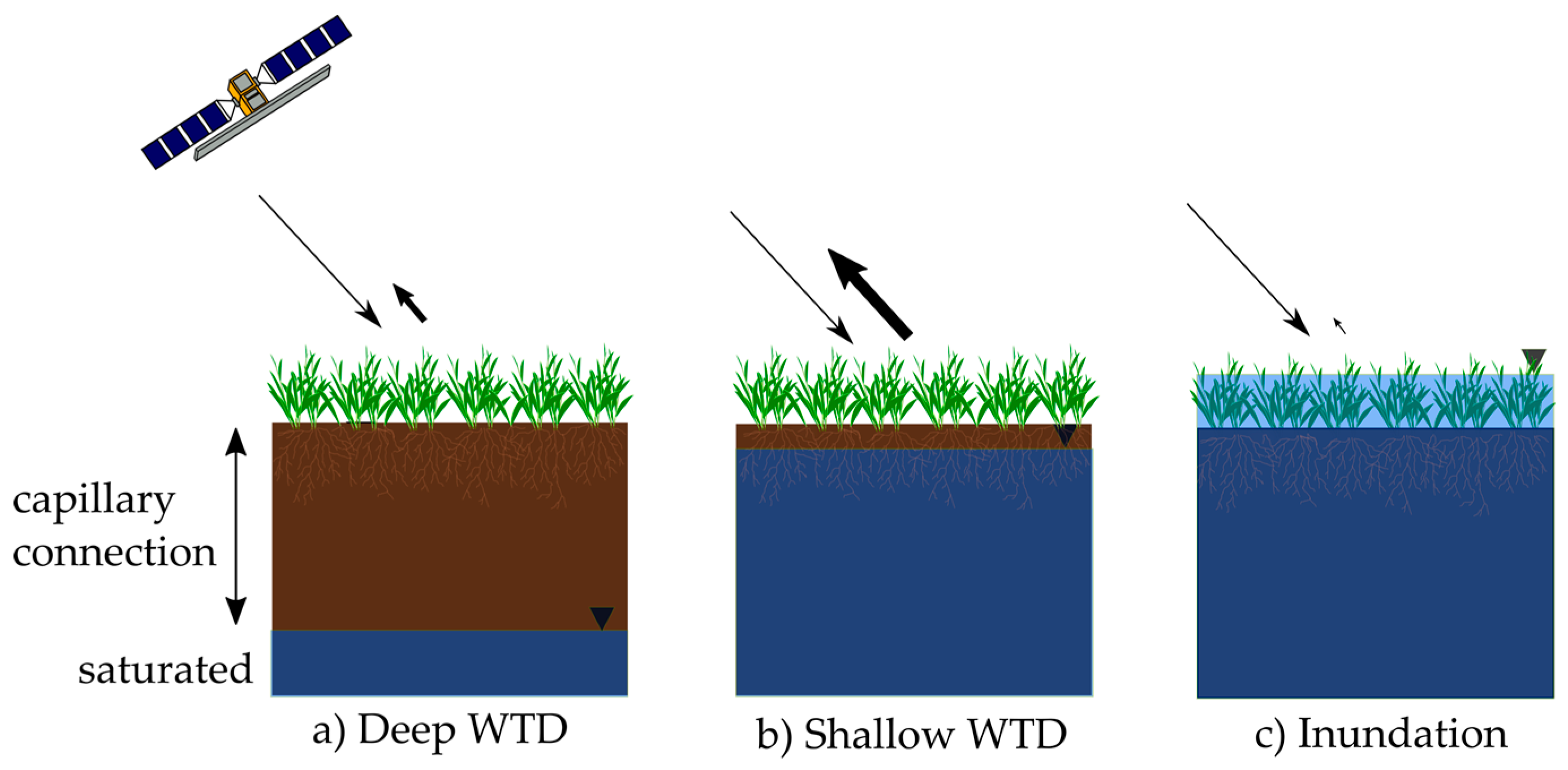
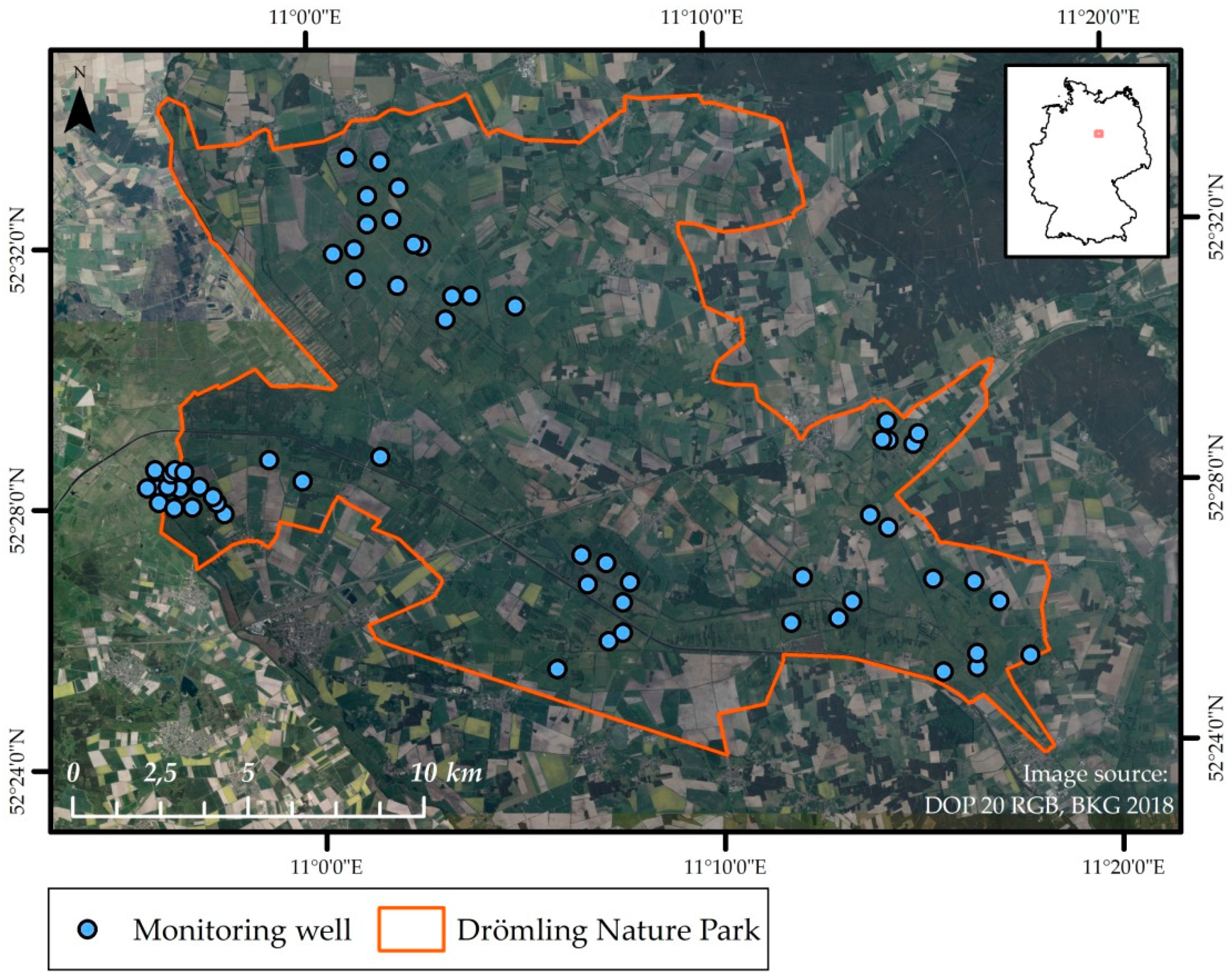
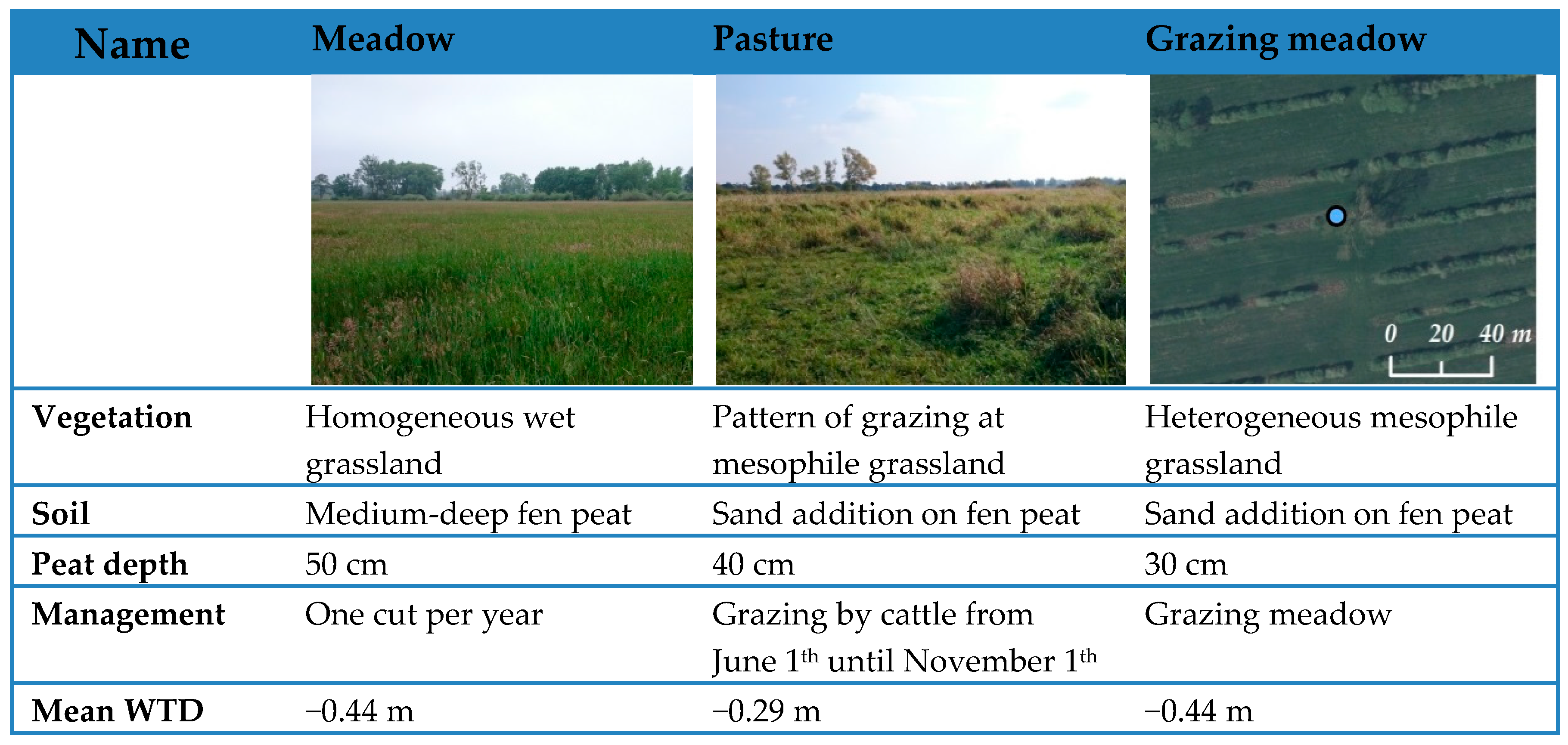
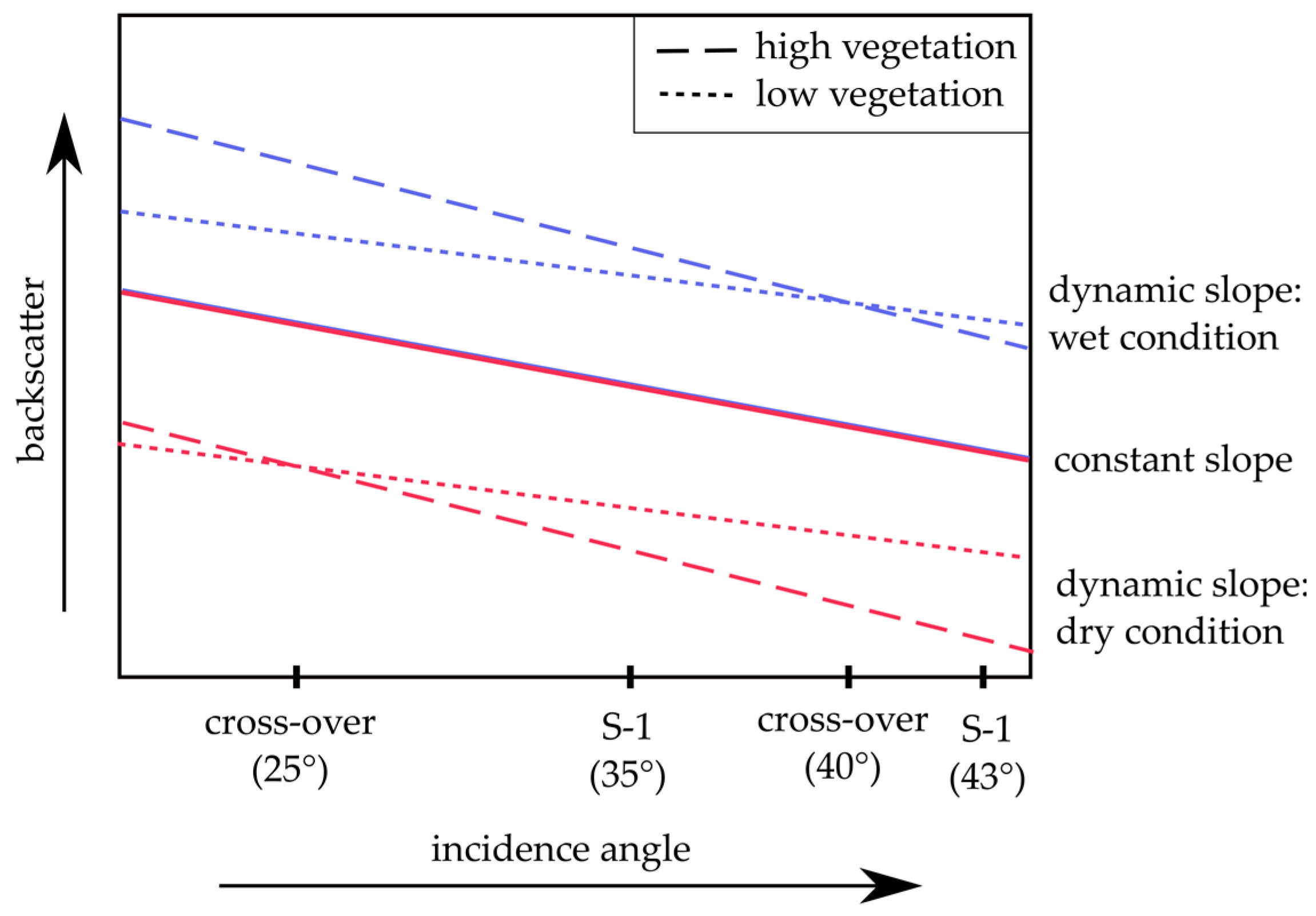
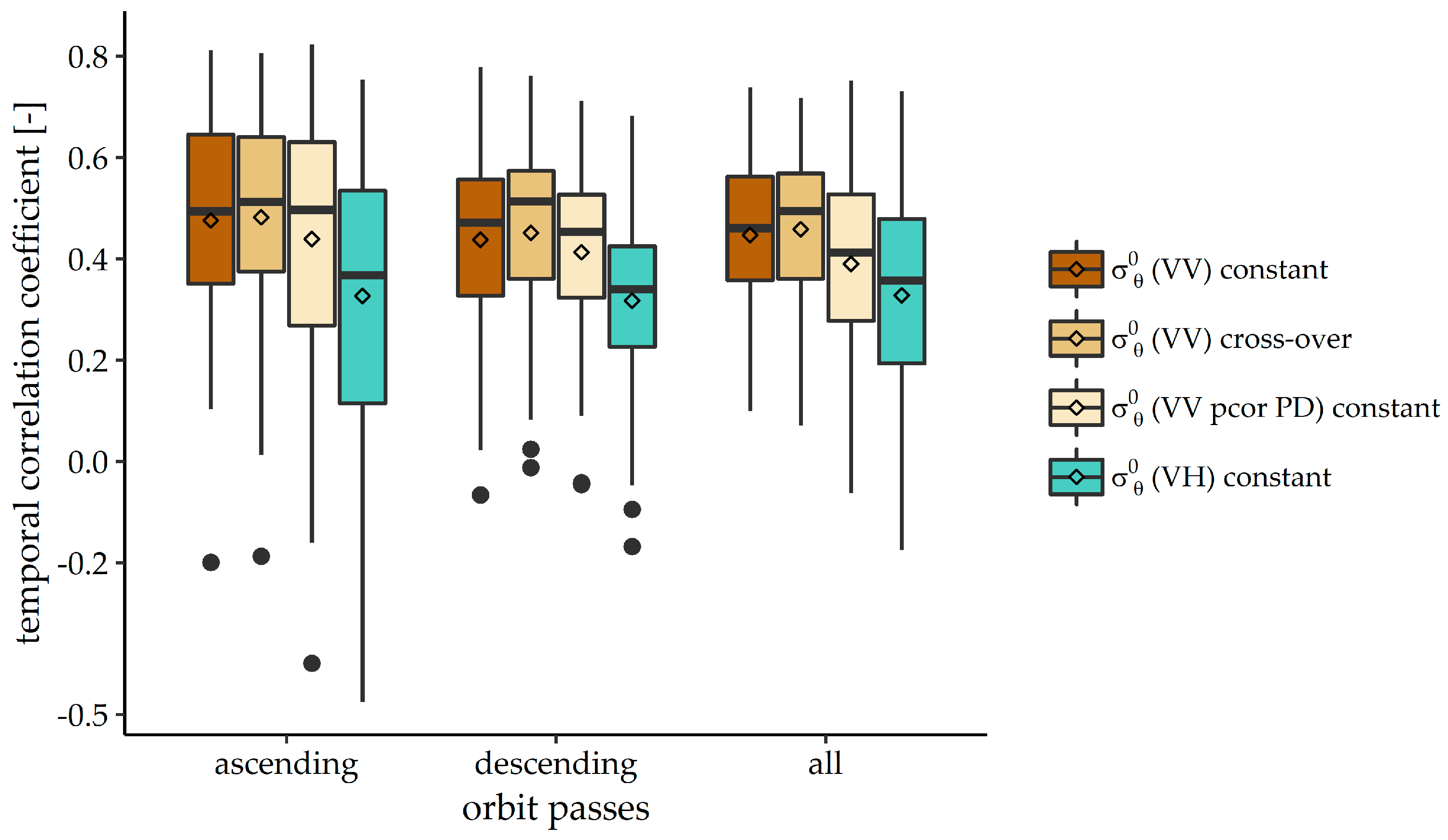
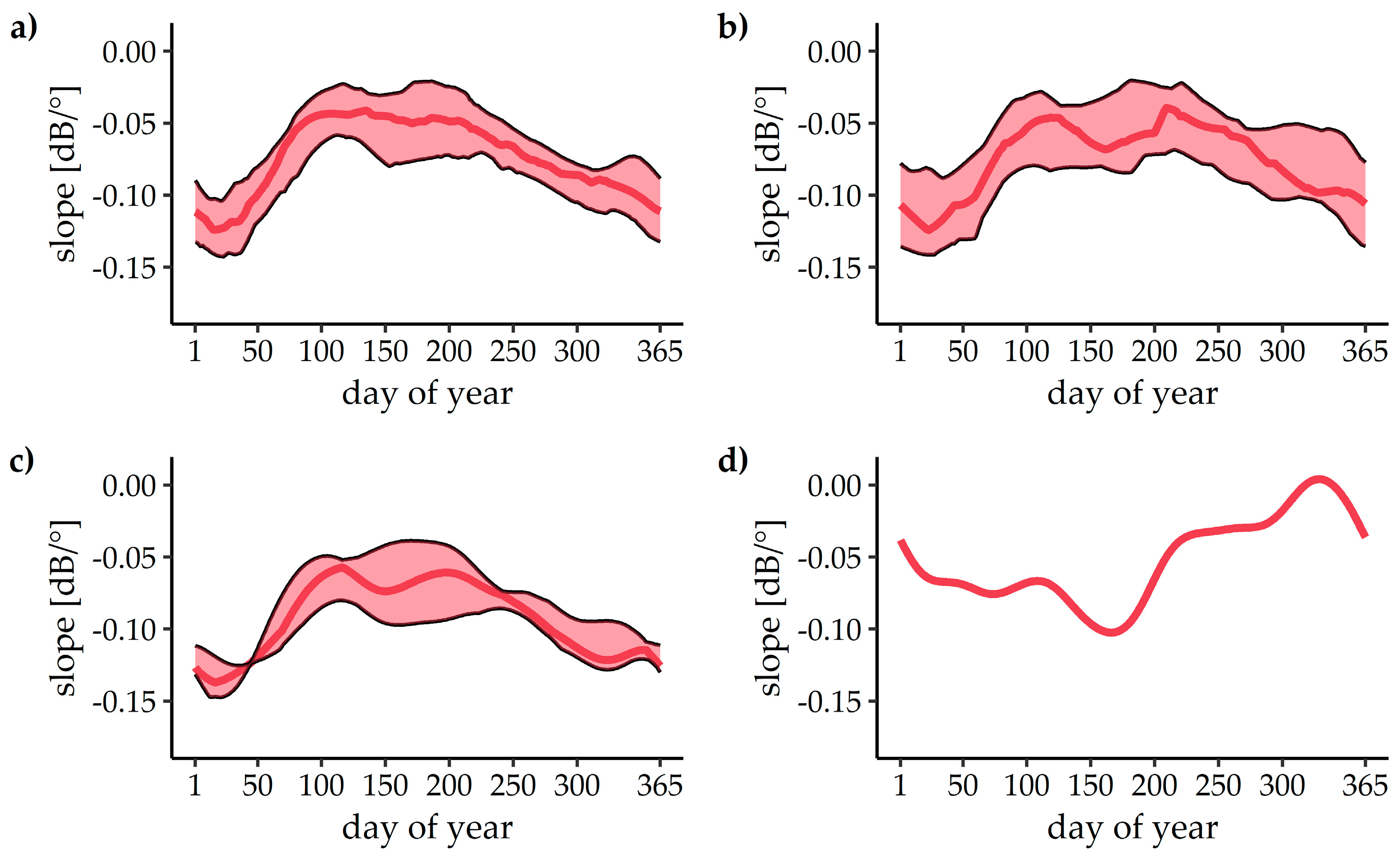
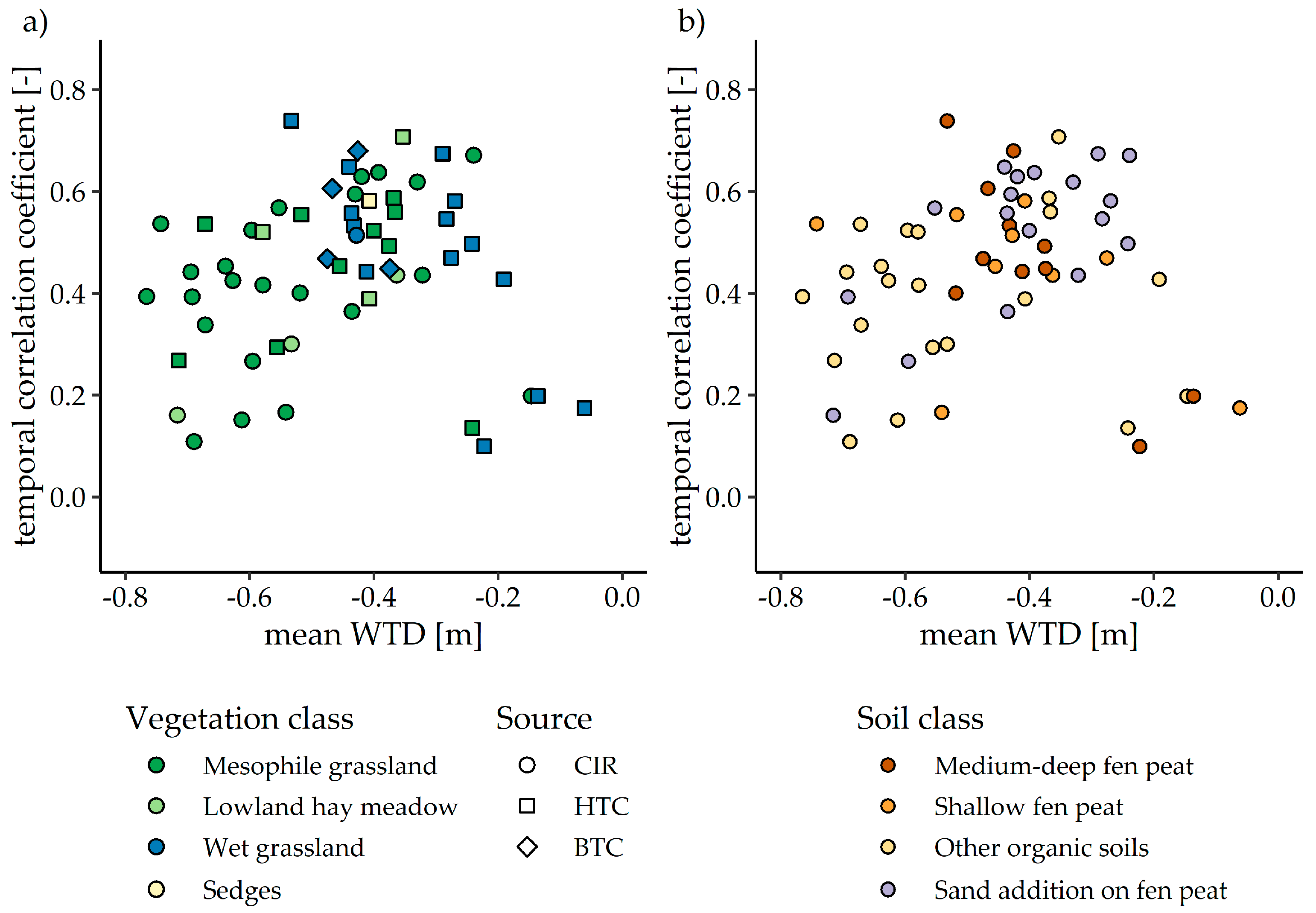
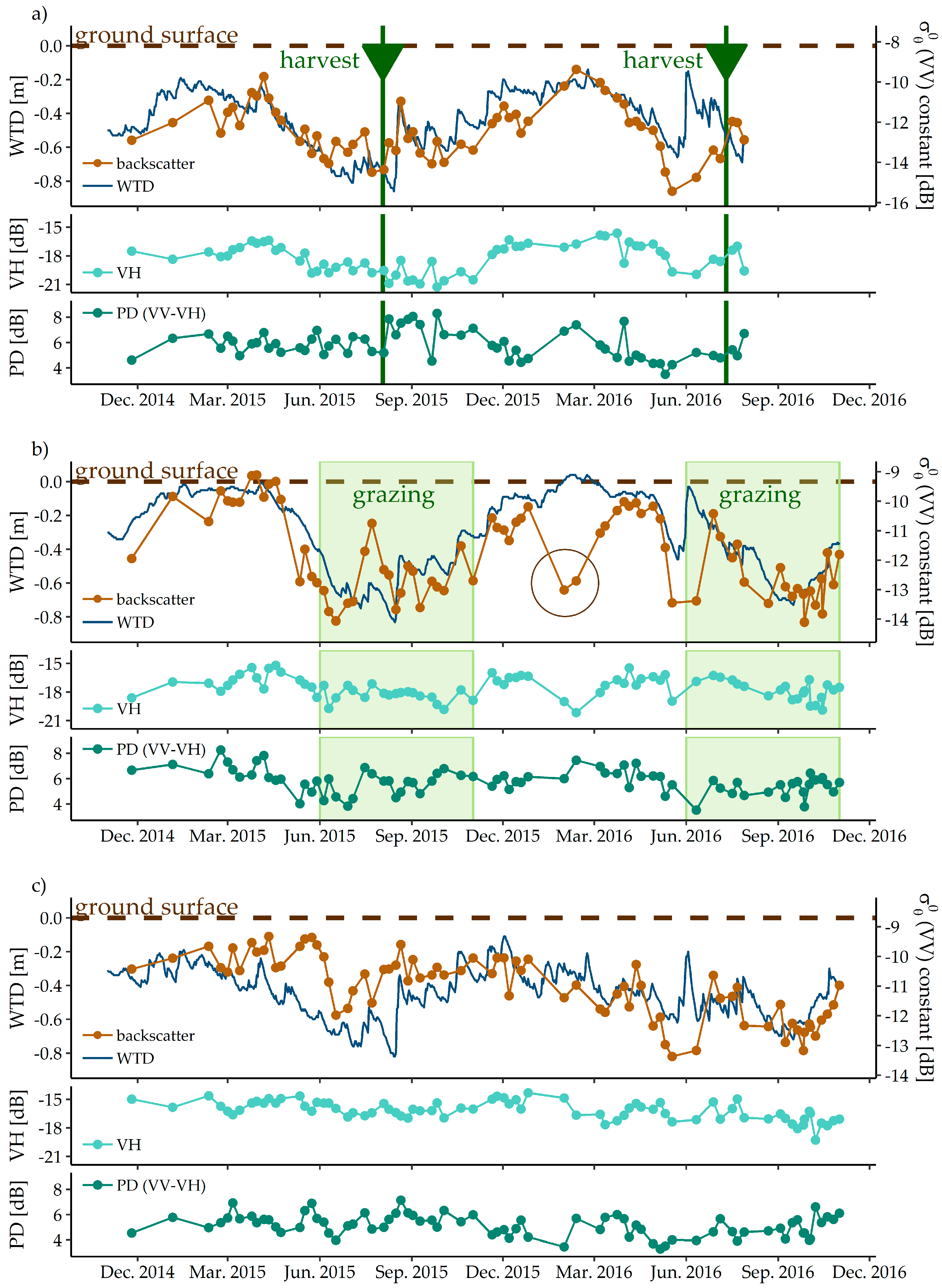
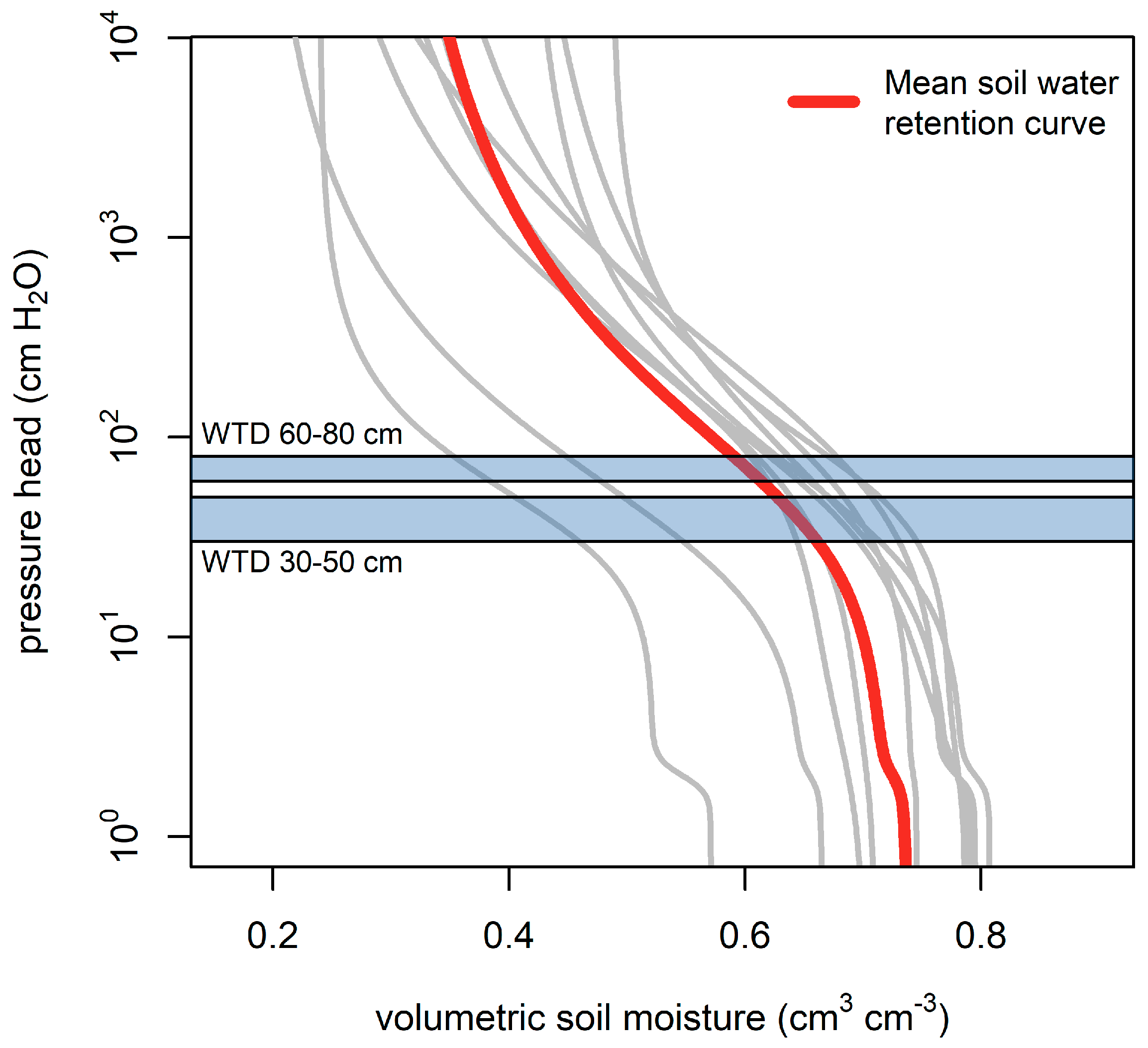
© 2019 by the authors. Licensee MDPI, Basel, Switzerland. This article is an open access article distributed under the terms and conditions of the Creative Commons Attribution (CC BY) license (http://creativecommons.org/licenses/by/4.0/).
Share and Cite
Asmuß, T.; Bechtold, M.; Tiemeyer, B. On the Potential of Sentinel-1 for High Resolution Monitoring of Water Table Dynamics in Grasslands on Organic Soils. Remote Sens. 2019, 11, 1659. https://doi.org/10.3390/rs11141659
Asmuß T, Bechtold M, Tiemeyer B. On the Potential of Sentinel-1 for High Resolution Monitoring of Water Table Dynamics in Grasslands on Organic Soils. Remote Sensing. 2019; 11(14):1659. https://doi.org/10.3390/rs11141659
Chicago/Turabian StyleAsmuß, Tina, Michel Bechtold, and Bärbel Tiemeyer. 2019. "On the Potential of Sentinel-1 for High Resolution Monitoring of Water Table Dynamics in Grasslands on Organic Soils" Remote Sensing 11, no. 14: 1659. https://doi.org/10.3390/rs11141659
APA StyleAsmuß, T., Bechtold, M., & Tiemeyer, B. (2019). On the Potential of Sentinel-1 for High Resolution Monitoring of Water Table Dynamics in Grasslands on Organic Soils. Remote Sensing, 11(14), 1659. https://doi.org/10.3390/rs11141659







